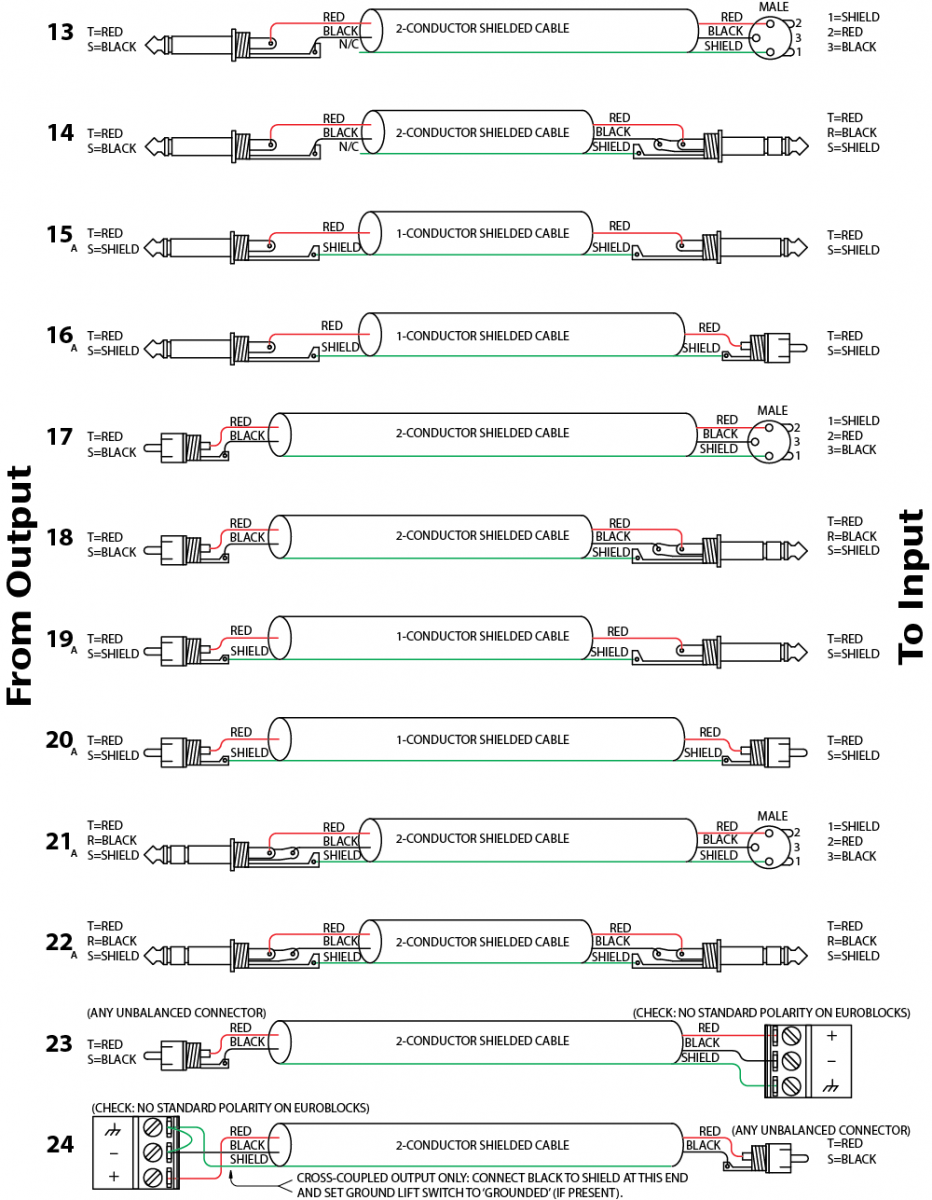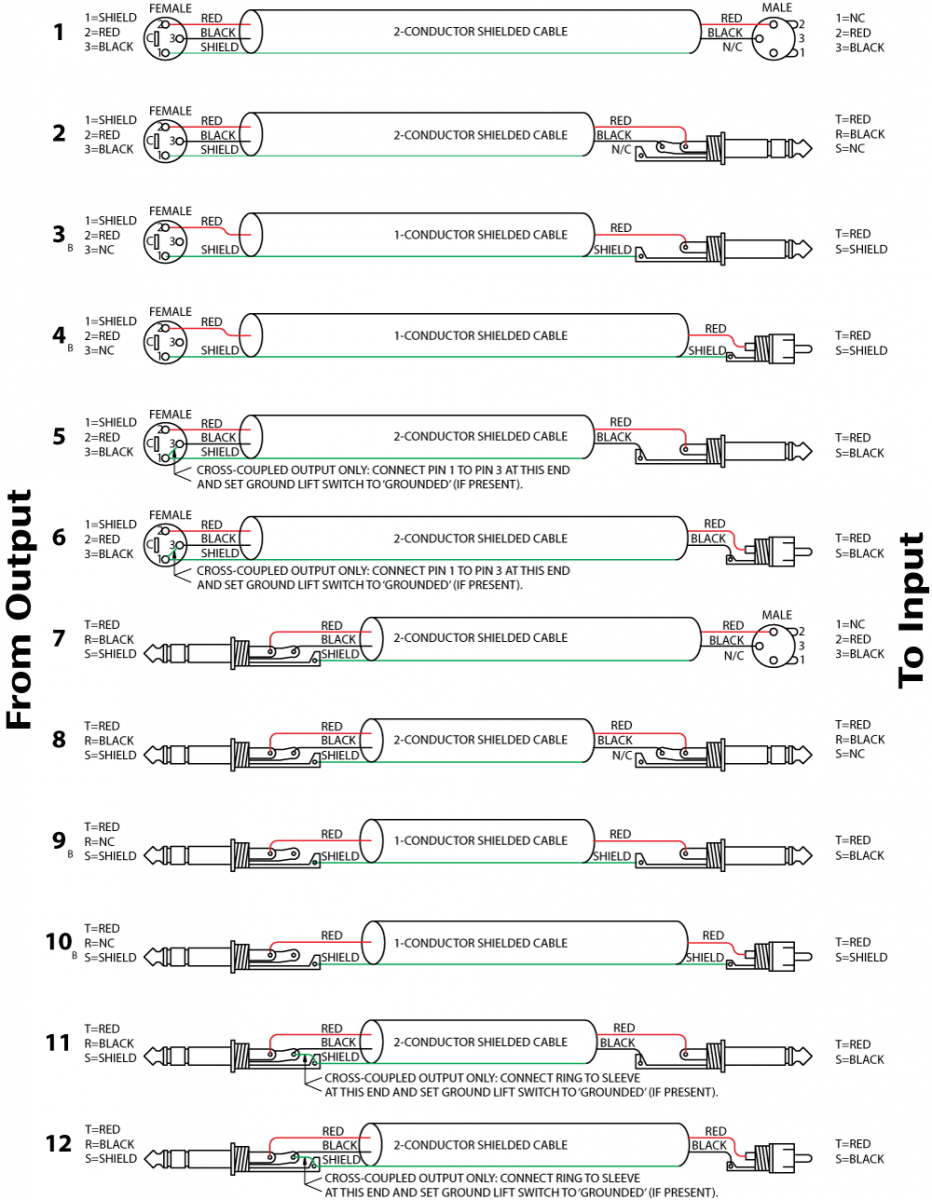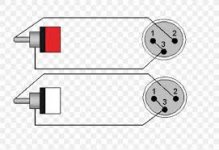Dear all
I bought a DBX 234xs crossover which I need to interface with my hifi system.
The DBX xover is a professional device and I'd like to undestand what's the best way to connect it between my unbalanced preamp and power amp. I know that working with balanced/unbalanced devices can be tricky.
I plan to build my cables. I have RCA female connectors on both amp and preamp. The xover has female XLR input and male XLR output socket.
Can you suggest the best way to connect?
Pietro
I bought a DBX 234xs crossover which I need to interface with my hifi system.
The DBX xover is a professional device and I'd like to undestand what's the best way to connect it between my unbalanced preamp and power amp. I know that working with balanced/unbalanced devices can be tricky.
I plan to build my cables. I have RCA female connectors on both amp and preamp. The xover has female XLR input and male XLR output socket.
Can you suggest the best way to connect?
Pietro
Hi, this is a good reference for different methods of connecting equipment
RANE Commercial - Knowledge Base
RANE Commercial - Knowledge Base
You can use the RCA female to XLR male adapters. There's quite a range out there.
Hosa RCA Female to XLR Male Adaptor [GXM-133] : AVShop.ca - Canada's Pro Audio, Video and DJ Store
You can get ones a lot cheaper than this.
Hosa RCA Female to XLR Male Adaptor [GXM-133] : AVShop.ca - Canada's Pro Audio, Video and DJ Store
You can get ones a lot cheaper than this.
Connection 17 in the Rane document linked by SJ is what you need. This uses 2 conductor shielded cable with the shield connected only at the XLR end.
An alternative connection which uses single conductor shielded cable is shown in the attachment, but the Rane connection should be superior.
An alternative connection which uses single conductor shielded cable is shown in the attachment, but the Rane connection should be superior.
Attachments
thanks to all this is very good! In order to implement the RANE scheme maybe the best thing is to look for a good microphone professional cable like the Mogami. What do you think?
What cable lengths are involved?
I have never experienced any noise issues with just leaving pin3 unconnected, pro equipment typically accepts balanced and unbalanced connections equally well since the signal path though the device is unbalanced after the differential input opamp anyway.
I have never experienced any noise issues with just leaving pin3 unconnected, pro equipment typically accepts balanced and unbalanced connections equally well since the signal path though the device is unbalanced after the differential input opamp anyway.
That is short so any decent quality cable will suffice, if you didn't experience any induced noise issues with the system before adding the DBX unit you should not have any afterwords.
And there is nothing wrong with trying both methods here, build one of each and try them.. there should be no difference in noise level but if there is use the other method.
But since you don't need a balanced cable and long unused wires can act as an antanna I suggest simply using an RCA cable to start, chop off one end and solder on an XLR connector, try it with pin 3 shorted to the shield and without. If that proves to be noise free in your environment then you know you don't need a higher spec cable.
And there is nothing wrong with trying both methods here, build one of each and try them.. there should be no difference in noise level but if there is use the other method.
But since you don't need a balanced cable and long unused wires can act as an antanna I suggest simply using an RCA cable to start, chop off one end and solder on an XLR connector, try it with pin 3 shorted to the shield and without. If that proves to be noise free in your environment then you know you don't need a higher spec cable.
Galu was almost there, but the full truth is that you need TWO DIFFERENT CABLES depending and who´s sending and who´s receiving.
The problem being that modern equipment does NOT have true transformer balanced outputs or inputs which was the original spec but it is EMULATED by using 2 UNBALANCED outputs or inputs which are electronically out of phase to achieve the balancing benefits but there is a compromise involved.
main problem being that like on any active device, amp or preamp, you must NOT ground outputs.
No big deal on grounding inputs though. Like on any preamp or power amp.
As in: do NOT ground pin 2 or 3 at the output/send side.
So for the RCA SEND to XLR RECEIVE cable you use #17
pins 2 and 3 can be safely joined.

and for the XLR SEND to RCA RECEIVE you use #4
Notice pin 3 is NC: NOT CONNECTED
http://kb.inmusicbrands.com/media/images/rane/n110fig4a.png
Mark your cables accordingly, as in using a piece of Red tape around SEND end and Blue/Green/White/Yellow (your choice) at the RECEIVE end
Plan B, "almost universal safe cable"
make all like #4 , with Pin 3 UNCONNECTED

Why "almost" universal?
because it will work with ALL MODERN (electronically balanced) equipment, but not with the old style true transformer balanced type.
Which you will almost never find anyway (scarce and expensive).
The problem being that modern equipment does NOT have true transformer balanced outputs or inputs which was the original spec but it is EMULATED by using 2 UNBALANCED outputs or inputs which are electronically out of phase to achieve the balancing benefits but there is a compromise involved.
main problem being that like on any active device, amp or preamp, you must NOT ground outputs.
No big deal on grounding inputs though. Like on any preamp or power amp.
As in: do NOT ground pin 2 or 3 at the output/send side.
So for the RCA SEND to XLR RECEIVE cable you use #17
pins 2 and 3 can be safely joined.

and for the XLR SEND to RCA RECEIVE you use #4
Notice pin 3 is NC: NOT CONNECTED
http://kb.inmusicbrands.com/media/images/rane/n110fig4a.png
Mark your cables accordingly, as in using a piece of Red tape around SEND end and Blue/Green/White/Yellow (your choice) at the RECEIVE end
Plan B, "almost universal safe cable"
make all like #4 , with Pin 3 UNCONNECTED

Why "almost" universal?
because it will work with ALL MODERN (electronically balanced) equipment, but not with the old style true transformer balanced type.
Which you will almost never find anyway (scarce and expensive).
since no one was brought up the difference in levels between pro and consumer levels or pads i'll leave that to the paduwans here...
gain and residual noise levels are cause and effect ,no?
gain and residual noise levels are cause and effect ,no?
Yes JMF, I should have realised that because I used connection method #4 when connecting my son's electronically balanced recording interface to a stereo amp!
Your information is well worth saving. 😎
Your information is well worth saving. 😎
since no one was brought up the difference in levels between pro and consumer levels....
Makes almost no difference to a crossover. It does not have a threshold level. Overload level is above any sane need. Hiss level is below most systems.
Thanks to all. The Rane document was very good, thanks for linking.
Therefore I should to this ways
Connection 17: Preamp rca out --> Xover xlr input

Connection 4: Xover xlr out --> Amp rca input
However, I build my cables with CAT5 solid core twisted pairs terminated with rca for unbalanced connections. I always found they sound very good and cost nothing. The problem is that this way I don't have a shield.
This shouldn't be a big problem with "connection 4", but it is for connection 17 (preamp --> xover). In this case, is that a problem if I leave pin 1 on the xlr input (crossover side) unconnected?
Shielding was never a problem for my unbalanced connections, I never do cables longer than 1meter.
What do you thing?
Therefore I should to this ways
Connection 17: Preamp rca out --> Xover xlr input

Connection 4: Xover xlr out --> Amp rca input
An externally hosted image should be here but it was not working when we last tested it.
However, I build my cables with CAT5 solid core twisted pairs terminated with rca for unbalanced connections. I always found they sound very good and cost nothing. The problem is that this way I don't have a shield.
This shouldn't be a big problem with "connection 4", but it is for connection 17 (preamp --> xover). In this case, is that a problem if I leave pin 1 on the xlr input (crossover side) unconnected?
Shielding was never a problem for my unbalanced connections, I never do cables longer than 1meter.
What do you thing?
Last edited:
I don't know, I am not a tech, but a lot of people use twisted pairs cables without shields without problems.
My system has a pretty high resolution and very low noise floor. I use those kind of cables everywhere except that for phono, and I don't get any noise (with my unbalanced eletronics)
My system has a pretty high resolution and very low noise floor. I use those kind of cables everywhere except that for phono, and I don't get any noise (with my unbalanced eletronics)
Unbalanced interconnects should always be shielded.
There's no reason not to use a shield, it's good practice, there's usually an RF filter on inputs.
Certainly, the signal transfer will not be affected if you omit the screen.is that a problem if I leave pin 1 on the xlr input (crossover side) unconnected?
I'm not sure I understand what you are saying, the signal will almost certainly be affected if you omit the screen. You may find this thread interesting Cable shield as a Faraday cage
- Home
- Source & Line
- Analog Line Level
- Interconnects to/from professional xover
